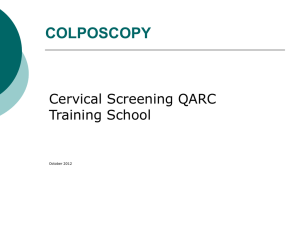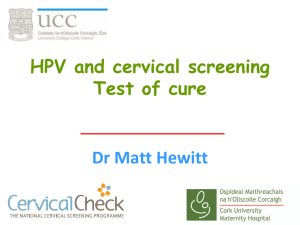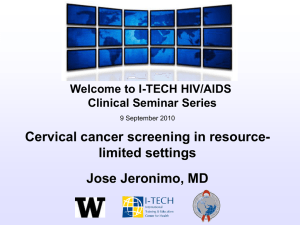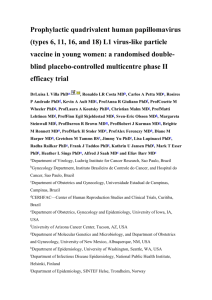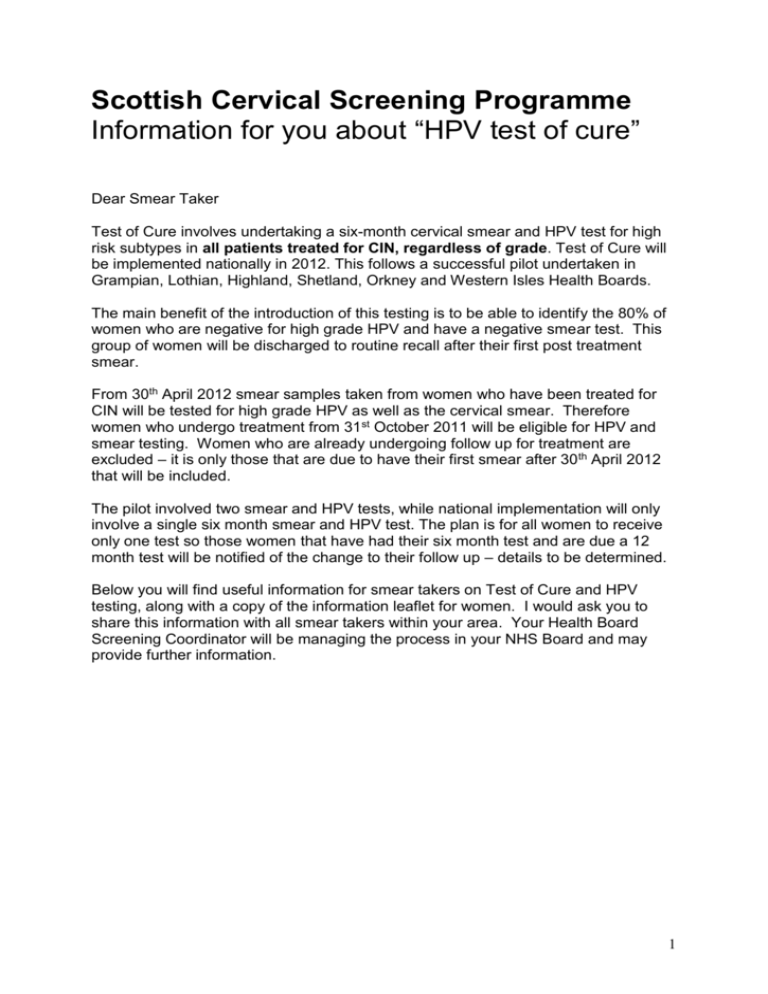
Scottish Cervical Screening Programme
Information for you about “HPV test of cure”
Dear Smear Taker
Test of Cure involves undertaking a six-month cervical smear and HPV test for high
risk subtypes in all patients treated for CIN, regardless of grade. Test of Cure will
be implemented nationally in 2012. This follows a successful pilot undertaken in
Grampian, Lothian, Highland, Shetland, Orkney and Western Isles Health Boards.
The main benefit of the introduction of this testing is to be able to identify the 80% of
women who are negative for high grade HPV and have a negative smear test. This
group of women will be discharged to routine recall after their first post treatment
smear.
From 30th April 2012 smear samples taken from women who have been treated for
CIN will be tested for high grade HPV as well as the cervical smear. Therefore
women who undergo treatment from 31st October 2011 will be eligible for HPV and
smear testing. Women who are already undergoing follow up for treatment are
excluded – it is only those that are due to have their first smear after 30 th April 2012
that will be included.
The pilot involved two smear and HPV tests, while national implementation will only
involve a single six month smear and HPV test. The plan is for all women to receive
only one test so those women that have had their six month test and are due a 12
month test will be notified of the change to their follow up – details to be determined.
Below you will find useful information for smear takers on Test of Cure and HPV
testing, along with a copy of the information leaflet for women. I would ask you to
share this information with all smear takers within your area. Your Health Board
Screening Coordinator will be managing the process in your NHS Board and may
provide further information.
1
Information for sample takers
This fact sheet informs sample takers and helps them to counsel women who are
having a HPV test as part of the Scottish Cervical Screening Programme.
How does this affect me as a smear taker?
You don’t need to do anything different when taking a smear.
You will see changes on SCCRS.
o The CCR View has been modified to show HPV test result information where
this exists.
o To accommodate the new virology result, the Person’s Result History table
has been updated to split the ‘result’ column into a ‘Cytology Result’ and an
‘HPV Result’ column.
o Text appearing within any Person ‘Event’ detail screen for a result has been
updated to help differentiate between a ‘cytology’ and ‘virology’ result.
Previous text of ‘Result’ will now read as ‘Cytology Result’ and where virology
results exist these will appear within a new heading of ‘HPV result’.
o With the introduction of Test of Cure new mailer types will become available.
You need to be able to advise women about HPV testing as part of Test of Cure –
see information below.
What is Human Papilloma Virus (HPV)?
HPV is a very common virus which, although usually harmless, can damage cells
including those in the cervix. There are around 100 different types of HPV. Usually
the body’s immune system fights off HPV infections naturally. However, some types
of HPV are harder to get rid of and some (most notably types 16 and 18) have been
confirmed as agents causing cervical cancer. Unlike types 6 and 11 (which cause
genital warts) these ‘high risk’ types do not produce visible symptoms. Almost all
cervical cancers contain HPV DNA.
Looking at cases of CIN, we find that the higher the grade of CIN the more often high
risk HPV infection is found. This suggests that women showing no signs of infection
with HPV are extremely unlikely to develop cervical cancer in the short to medium
term. Even if a woman does have abnormal cytology, it is unlikely to reflect CIN2 or
3; in most cases it will be a result of low-grade abnormalities that regress without
treatment. Infection with HPV is common, especially in women under 35. In most
cases the infection is transient. However, for reasons that are not yet known around
20–30% of women do not clear the infection. This group is at most risk of CIN that
may eventually develop into cervical cancer.
How do women get the virus?
Most cases of high risk HPV infection is transmitted by being sexually intimate with
another person who has the virus as HPV is mainly spread by skin-to-skin contact
during sexual activity.
2
However, there are two important factors to bear in mind:
the infection is asymptomatic, so it may have been present and undetected for
many years and have nothing to do with a woman’s current relationship
a partner may have acquired an asymptomatic infection with no visible lesions
many years earlier and passed it on unknowingly.
Women can therefore be reassured that a positive test result for high-risk HPV types
need not imply infidelity or promiscuity by either partner.
Why are we using HPV testing following treatment for CIN?
HPV testing is designed to allow women to return to routine three yearly screening
after just six months. The follow up of treated women may involve annual cytology
screening for five years before they return to routine recall. The HPV test of cure can
avoid the need for this by helping to assess the risk of residual disease in women.
Women who have normal cytology and HPV negative six months after treatment will
return to routine recall.
How is the test done?
HPV testing is performed on the sample taken for the cytology test, so there is no
need for the woman to be called for a second test.
Samples will be processed at the laboratory and all results will be issued as part of a
single cytology report. A cytology report will include a result and a management
recommendation, as happens now. If the result shows high-risk HPV this will be
included in the report and reflected in the management recommendation.
How will HPV testing affect women?
All women who have been treated for high grade CIN will have a cytology and HPV
test six months after their treatment. Women who are HPV negative will return to
routine three year recall. Women who are HPV positive or have abnormal cytology
will be referred back to colposcopy.
Does the HPV test affect colposcopy?
The HPV test focuses on which women will go to colposcopy and which can proceed
to a three year recall period following treatment. At colposcopy, women’s clinical
management will depend (as now) on the opinion of the colposcopist who examines
the cervix.
3
Frequently asked questions
Human Papilloma Virus
What is Human Papilloma Virus (HPV)?
HPV is a very common virus which, although usually harmless, can damage cells
including those in the cervix. There are around 100 different types of HPV and
around 15 HPV types can damage the cells in the cervix. Usually the body’s immune
system fights off HPV infections naturally. However, some types of HPV are harder
to get rid of and some (most notably types 16 and 18) have been confirmed as
agents causing cervical cancer. It is these types that are being tested for. Unlike
types 6 and 11 (which cause genital warts) these types do not produce visible
symptoms. Almost all cervical cancers contain HPV DNA.
The virus replicates within the epithelium or mucosa of the cervix and sheds in
exfoliated cells which can be detected in cytology samples.
Why test for HPV?
HPV testing is designed to allow women to return to routine three yearly screening
after just six months. The follow up of treated women may involve annual cytology
screening for five years before they return to routine recall. The HPV test of cure can
avoid the need for this by helping to assess the risk of residual disease in women.
Women who have normal cytology and HPV negative six months after treatment can
safely return to routine three yearly screening.
How is the test done?
HPV testing is performed on the sample taken for the cytology test. The material left
after the cytology slides have been prepared is used to test for HPV.
How is HPV acquired?
Most cases of high risk HPV infection is transmitted by being sexually intimate with
another person who has the virus as HPV is mainly spread by skin-to-skin contact
during sexual activity - it can be spread without penetration occurring.
However, there are two important factors to bear in mind:
the infection is asymptomatic, so it may have been present and undetected for
many years and have nothing to do with a woman’s current relationship
a partner may have acquired an asymptomatic infection with no visible lesions
many years earlier and passed it on unknowingly.
Women can therefore be reassured that a positive test result for high-risk HPV types
need not imply infidelity or promiscuity by either partner.
It is common for women to state that their current partner has been their only sexual
partner, and for their partner to say the same. Theoretically, if two virgins form a
faithful sexual relationship there should be no opportunity to acquire HPV. Yet we
know that some women in relationships of this type do test HPV positive. HPV
infections can persist for many years and it is not possible to be sure when the
4
infection occurred or what its true source is. Certainly the HPV types most often
associated with cervical cancer are usually symptomless in both partners.
This can be a difficult area, but a sensitive, gentle explanation of the facts as we
understand them usually suffices. If a woman who has had only one sexual partner
acquires cervical HPV do not be tempted to suggest that this indicates infidelity.
How long does HPV infection last?
HPV infection of the cervix usually occurs earlier in the sexual lives of women. We
know this because HPV positive rates are about 50% in women around the age of
20. In most women the infection clears, usually within a year, and protective
antibodies may develop to prevent future infection by the same HPV type. However,
this does not always happen and it is not uncommon to acquire new HPV infections
of a different type. In some women (probably 20–30%) the infection persists and may
do so for years. The longer the infection persists the greater the risk of subsequent
abnormality.
How can high-risk HPV cause cancer?
HPV contains several genes that can disturb the mechanisms regulating normal cell
division, which then becomes uncontrolled. It is thought that HPV alone may not be
sufficient to cause cancer and that other factors, such as smoking, may play a part.
Can HPV infection be treated?
At present there is no effective treatment for HPV infection but, as stated, the
immune system clears most infections.
Can HPV infection be prevented?
Research suggests that the two vaccines developed by international pharmaceutical
companies are very effective at preventing infection with the two virus types most
commonly linked with cervical cancer, but these types are responsible for only
around 70% of cases. A national HPV immunisation programme is currently under
way to routinely vaccinate girls aged 12–13 years. The vaccine will not protect
against HPV infections picked up before being immunised, or against HPV infections
caused by the other high risk types. So although the vaccine offers good protection,
it is still important for women to attend for regular cervical screening tests.
5
The Cervical Screening Test
Information for women after treatment for cervical
intraepithelial neoplasia (CIN) at a colposcopy clinic
What happens after cervical intraepithelial neoplasia (CIN) treatment?
After treatment for CIN cells of the cervix (the neck of the womb) you will have a test
to check that your treatment has been successful. This test will take place about six
months after your treatment. It will be carried out at your GP practice, where you
usually have your cervical screening test taken or occasionally back at a colposcopy
clinic.
This test includes:
• checking the cells from your cervix (the same as a cervical screening test)
• a test for the human papilloma virus (HPV).
Only one sample will be taken. This will be used to check the cells from your cervix
and test for HPV.
What is CIN?
CIN is the name for changes found in the cells of the cervix. There are two grades of
CIN – high-grade (CIN2 and 3) and low-grade (CIN1). Additionally, there are other
types of cervical abnormality.
What is HPV?
HPV is a very common virus which, although usually harmless, can damage cells –
including those in the cervix. It is estimated that 8 out of 10 people in
Scotland catch HPV at some time in their lives. Many people have HPV without
knowing because there are usually no symptoms. There are over 100 different types
of HPV. Usually your body’s immune system fights off HPV infections naturally, but
some types of HPV can be harder to get rid of. Around 15 HPV types can damage
the cells in the cervix and cause changes that can develop into CIN. CIN is detected
by cervical screening and colposcopy and may require treatment. If left untreated,
CIN can develop into cancer over many years.
How do people get HPV?
You can be exposed to HPV by being sexually intimate with another person who has
the virus, as HPV is mainly spread by skin-to-skin contact during sexual activity.
Why am I being tested for HPV following treatment for CIN?
Until recently, women treated for CIN had a cervical screening test every year, for
five years, following treatment. After this they returned to routine three yearly
screening. The HPV test is important because we now know that women who have a
test six months after treatment that shows normal cervical cells and no HPV (HPV
negative) can safely return to routine three yearly screening. This means that women
can return to routine screening more than four years earlier than before.
6
My letter says that I have no changes.
If HPV is not found six months after treatment and there are no changes in the cells
in your cervix, you will return to routine three yearly screening. This means that your
previous CIN treatment has been successful.
My letter says that there were not enough cells.
Your cervical screening test result may show that there were not enough cells in the
sample for the laboratory to examine. This is not unusual and you will be invited back
for a repeat test.
My letter says that I have changes.
If HPV is found six months after treatment and there are changes in the cells in your
cervix, you will be invited back to the colposcopy clinic. Please note that although 1 in
5 women will be invited back to the colposcopy clinic, only a few will need another
treatment. It can take longer than six months for your immune system to clear HPV
after treatment.
Where can I find out more about HPV?
If you would like more information about HPV testing or anything else mentioned in
this leaflet, you can talk to your practice nurse or staff at the colposcopy clinic. There
is also information about cervical screening and HPV on the NHS inform website at
www.nhsinform.co.uk and the British Society for Colposcopy and Cervical
Pathology website at www.BSCCP.org.uk
Want to know more?
Talk to your nurse or doctor, visit www.nhsinform.co.uk or phone
the NHS inform helpline 0800 22 44 88 (textphone 18001 0800 22 44 88; the
helpline also provides an interpreting service)
7




